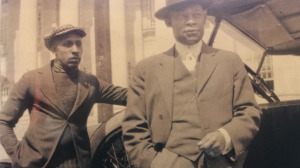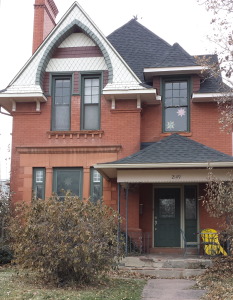We were leaving The Whittier Pub when a photo at the door stopped me. Like all the photos decorating the pub, it was a historic neighborhood black and white, acquired from the wonderful Colorado Historic Society/Denver Public Library collection. The gentleman in this photo wore a three-piece suit and a humorous, mocking look, away from, but perhaps for the camera. He radiated confidence. This guy was in charge.
Later, I chanced upon one of those Denver neighborhood history booklets, thumbed through it while in line to check out, and found that same photo. Colorado’s second black representative, Earl Mann was elected to five terms in the state legislature, served from 1944 – 1953.
Born June 8, 1886 in Iowa, Mann graduated from high school, attended a Chicago technical school for engineering. I imagine he was the only African American in some of those classes. One of the first blacks to be commissioned by the Army in 1917, he served in France in World War I, was chlorine gassed there. In the 30s and 40s, writing for The Colorado Statesman, an African American newspaper, he signed himself “Lieut. Earl W. Mann.” He was justly proud of that officer rank.
On May 17, 1930, his column was about a colored man being lynched in Sherman, Texas. (It was 1930. “Colored” was the polite usage.) He talks about the attempt a few years earlier to enact legislation “making lynching a federal offense… Its passage failed in the Congress.” They wouldn’t outlaw lynching. Incredible, isn’t it?
In the 50s, he and his wife Grace bought a home at 2149 High Street, two blocks on the wrong side of the color line. Twenty or so years earlier, blacks had been strongly discouraged from buying south of 23rd in east Denver. The KKK burned crosses on their lawns if they did. Mann surely knew that history and took satisfaction in living there.
In the Blair Caldwell Library’s collection, there’s a photo of him and several white men, all in suits and ties, sitting in his living room, a generous bookshelf filling the wall behind him. I made out two titles, the then popular historical novelist Thomas B. Costain, and a book about Liberia, the U.S. colony created to send freed slaves back to Africa. That brilliant plan didn’t work out. Mann lived in the High Street house until his death in 1969 and Grace remained there until hers, in 1974. They had no children.
On winning a place in the 1940 Republican primary, Lt. Mann wrote: “I feel confident of victory in November if TEN THOUSAND COLORED PEOPLE WILL SUPPORT ONE OF THEIR OWN, WITH THE SAME ENTHUSIASM AS ONE HUNDRED THOUSAND WHITES STAND WILLING TO DO.” (His caps. He felt the need to yell at his people.)
I did say Republican primary. In this neighborhood so solidly black and Democratic when I moved here in 1984, it seems odd. But it was so. It’s hard to remember that the party of Lincoln was once favored by minorities. There’s a photo of Mann with Mamie Eisenhower and her daughter at a political event in the 50s. When he won a place in that primary, the Statesman hoped he’d be elected, “which will be a signal honor to his race.”
Mann resisted such pigeonholing. Toward the end of his tenure in the legislature, he was charged with “misrepresenting” the Denver Negro community, in the Denver Post, March 9, 1953. He responded swiftly that he’d never claimed to serve only the Negro community, that he was elected to five terms “by overwhelming margins and the people knew I was a Negro. I do not get my support only from Denver Negroes and do not represent only Denver Negroes.” (It was the 50s. “Negro” was the polite usage.)
And the people knew I was a Negro: his mocking tone matches the look that stopped me at the pub. His “So They Say” columns, in the elaborate language of the day, often resist stereotyping and promote education:
“Ignorance is a blight, and those who merely stand upon the sidelines and sigh, making no effort to better conditions of which they complain, are in my judgment, but little better, if any, than those who contribute to moral and spiritual retrogression.” (Colorado Statesman, February 9, 1940)
He deals frankly with race in politics: “I resent just as greatly, hearing one of the Reactionary Republicans say: “You Colored people owe perpetual fidelity to the Party of Lincoln,” as I do hearing the Democrats say: “Our liberal social views preclude any distinction based upon race or color.”
Mann helped defeat the Alien Land Act, 1944, which would have forbidden Japanese from owning land in Colorado. His column on that was called “Taking the Heat,” and mentions the “flames of the KKK wrath” faced by those who opposed the bill. The bill “was merely fascism appearing in a new suit of clothes, without bathing, permitting the noxious body odors to disclose its identity, and its subtle purpose: Japanese and then Negroes and Jews.” (February 19, 1944)
Next time you’re in The Whittier for a burger and brew, pause at the door to salute Earl Mann, one of those who broke trail in Denver so others might more easily follow.



Very nice piece of History, Pat!!
Very nice read!If you have time, we would love it if you would help us out on history research for the Whittier Alley Loop project. We would like the history to be focused on the “color line” and community members who played a role in equal housing rights and civil rights. A graphic artist from the community is going to be creating markers along the loop that will include this information.
You can email me or Darrell for more info if you are interested!
ilovewhittiercommunity@gmail.com